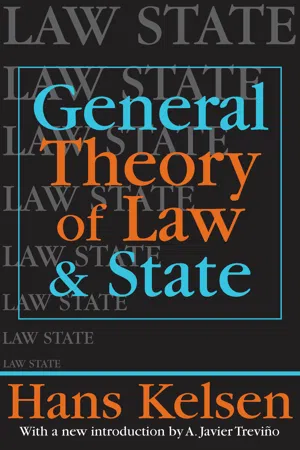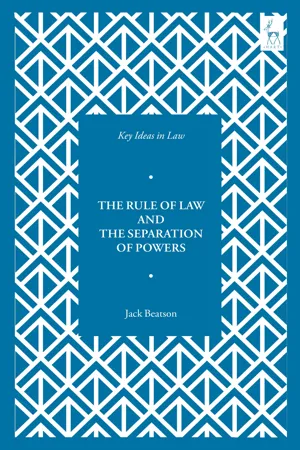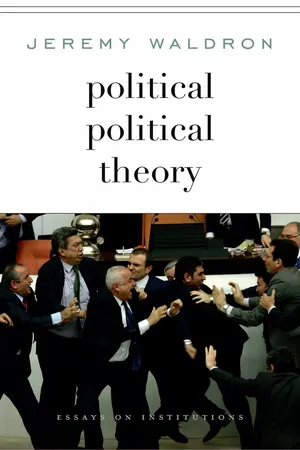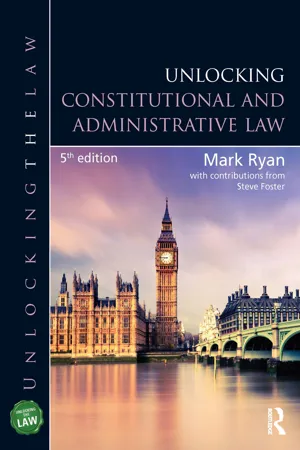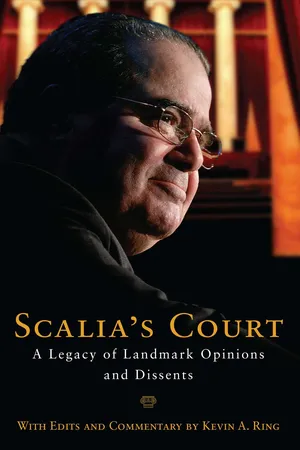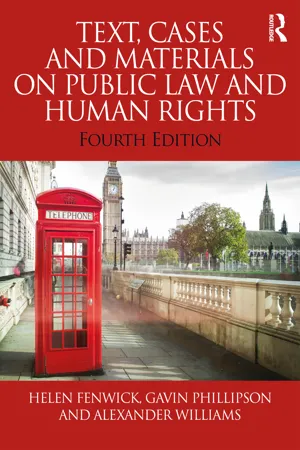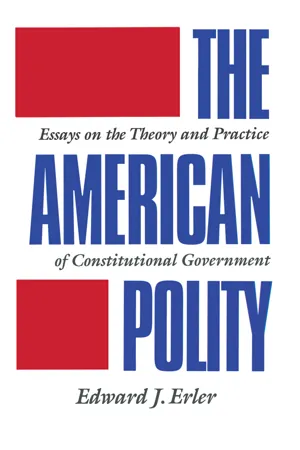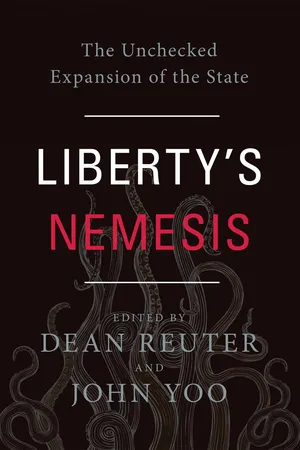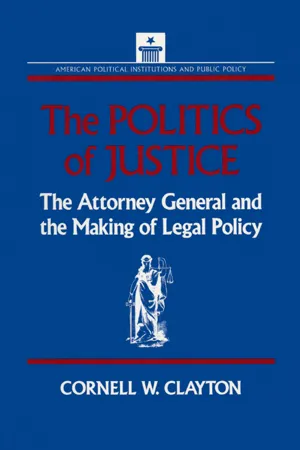Politics & International Relations
Separation of Powers
The concept of separation of powers refers to the division of government responsibilities into distinct branches, typically the legislative, executive, and judicial branches. This system aims to prevent the concentration of power in any one branch and to provide checks and balances, ensuring that no single branch becomes too powerful. The principle is fundamental to many democratic systems around the world.
Written by Perlego with AI-assistance
Related key terms
11 Key excerpts on "Separation of Powers"
- eBook - ePub
- Hans Kelsen(Author)
- 2017(Publication Date)
- Routledge(Publisher)
III. The Separation of PowersA. The Concept of “Separation of Powers”
The judicial review of legislation is an obvious encroachment upon the principle of Separation of Powers. This principle lies at the basis of the American Constitution and is considered to be a specific element of democracy. It has been formulated as follows by the Supreme Court of the United States: “that all the powers intrusted to government, whether State or national, are divided into the three grand departments, the executive, the legislative and the judicial. That the functions appropriate to each of these branches of government shall be vested in a separate body of public servants, and that the perfection of the system requires that the lines which separate and divide these departments shall be broadly and clearly defined. It is also essential to the successful working of this system that the persons intrusted with power in any one of these branches shall not be permitted to encroach upon the powers confided to the others, but that each shall by the law of its creation be limited to the exercise of the powers appropriate to its own department and no other.”†The concept of “Separation of Powers” designates a principle of political organization. It presupposes that the three so-called powers can be determined as three distinct coordinated functions of the State, and that it is possible to define boundary lines separating each of these three functions from the others. But this presupposition is not borne out by the facts. As we have seen, there are not three but two basic functions of the State: creation and application (execution) of law, and these functions are not coordinated but sub- and supra-ordinated. Further, it is not possible to define boundary lines separating these functions from each other, since the distinction between creation and application of law — underlying the dualism of legislative and executive power (in the broadest sense) — has only a relative character, most acts of State being at the same time law-creating and law-applying acts. It is impossible to assign the creation of law to one organ and the application (execution) of law to another so exclusively that no organ would fulfill both functions simultaneously. It is hardly possible, and at any rate not desirable, to reserve even legislation — which is only a certain kind of law-creation — to a “separate body of public servants” and to exclude all the other organs from this function. - Jack Beatson(Author)
- 2021(Publication Date)
- Hart Publishing(Publisher)
8 The Separation of Powers and the Balance of ResponsibilitiesThis chapter considers the way the Separation of Powers is reflected in our constitutional arrangements, whether such separation is fostered by a category of statutes recognised as ‘constitutional’, and the balance of responsibilities between courts and other branches of the state.I. THE Separation of PowersClassically the three locations of constitutional powers and functions are those of the legislative, the executive, and the judicial branches of the state. Sir Stephen Sedley 2015, 190, considers that today three further locations could be added, namely the established church, the media, and the security and intelligence services. While there is some force in his view that each ‘possesses a sufficient measure of autonomy to rank to some degree as a discrete element in the governance of the state’, this book only considers the three classical locations.What some have described as the pure or fundamental form of the principle requires an a priori classification of powers as either legislative, executive or judicial to determine which institution of the state should exercise a given function completely independently of the others. But as Sedley 2015, 172, stated:Plainly this is unreal: the judiciary has to be appointed and paid by a body other than itself; the law it interprets and applies has to be made in substantial part by a legislature; the legislature is largely dependent for its own functioning on the executive and political heads …; the executive requires a parliamentary mandate for much of what it does; and the courts have to be able to say whether the executive is acting within its mandate.France and the United States of America have been the states with forms of government closest to the pure form of the Separation of Powers. Until 1958, in France ministers could not sit in the legislature and the ordinary courts did not determine whether the legislature was acting constitutionally or whether the acts and omissions of the executive were lawful. Until the creation of the Conseil Constitutionnel, the Constitutional Council, in that year, the legislature itself determined whether it was acting constitutionally. The Conseil d’État, the Administrative Council, still determines the legality of executive action. The United States constitution seeks to avoid concentrations of power by forbidding those who hold executive office from being members of the legislature and vice versa, but it is the federal courts which have the ability to determine whether legislative and executive acts are legal and thus to restrain their exercises of power. In many other democracies with balanced constitutions, however, government ministers with executive responsibility are also members of the legislature and accountable to it, as well as to the electorate and to the ordinary courts.- eBook - ePub
- Jeremy Waldron(Author)
- 2016(Publication Date)
- Harvard University Press(Publisher)
CHAPTER THREESeparation of Powers and the Rule of LawMY TOPIC FOR this chapter is the Separation of Powers, conceived as a political principle for evaluating the legal and constitutional arrangements of a modern state. What is this principle, and why is it important? The question takes us in interesting directions if we distinguish the Separation of Powers from a couple of other important constitutional ideas that are commonly associated with it. The first of these is the principle of the dispersal of power—a principle that counsels us to avoid excessive concentrations of political power in the hands of any one person, group, or agency. The second is the principle of checks and balances—a principle that holds that the exercise of power by any one power-holder needs to be balanced and checked by the exercise of power by other power-holders. Does the principle of the Separation of Powers have any meaning over and above these two principles? I think it does, and in this chapter I want to explore aspects of the Separation of Powers that are independent of what we value in these two other principles.The Separation of Powers counsels a qualitative separation of the different functions of government—for example, legislation, adjudication, and executive administration. But the justification for this separation is not made clear in the canonical literature of seventeenth- and eighteenth-century political theory: Montesquieu’s “justifications,” for example, were mostly tautologies.1 And in the spirit of those tautologies, modern constitutionalism has, until recently, taken the Separation of Powers for granted. I mean it takes for granted that the Separation of Powers is necessary to avoid tyranny, but it does not explain why. I think a qualitative separation is - eBook - ePub
The Impossible State
Islam, Politics, and Modernity's Moral Predicament
- Wael Hallaq(Author)
- 2012(Publication Date)
- Columbia University Press(Publisher)
The aim, it must be stressed, is not to give an exhaustive account of this subject (on which a vast body of literature already exists) but rather to highlight briefly the structural problems that constitutional scholars have identified. If objection is made here to setting aside the blessings of the system of Separation of Powers, I plead that it is the problems, not the blessings (which surely exist), that must be, for obvious reasons, evaluated in an enquiry of the type we are conducting. If it turns out that the problems in the Western concept of separation are structural and multiple, then we can with justice say that Muslims, as well as other non-Western others, might want to approach the concept with due caution. 1. Separation of Powers in the Nation-State Both popular belief and much visionary political and constitutional theory advance the narrative that the separation of the three state powers or “branches of government”—the legislative, judicial, and executive—constitutes the backbone and foundation of liberty and democratic rule. 7 The vesting of power in three distinct, separate, and independent groups of institutions is said to be indispensable to the constitutional state, the site where the rule of law is deemed both most sustainable and meaningful. Likewise vital to this concept of separation is the notion that these three powers ought to be exercised by separately staffed departments, each being constitutionally equal and mutually independent. This mutual independence dictates—and this is particularly important to our argument—that the legislative branch must not ipso facto only enjoy total independence but that it also must not delegate its powers, especially to the executive. 8 This ideal has become a universal truism, endlessly repeated by political reform movements around the globe - eBook - ePub
- Mark Ryan, Steve Foster(Authors)
- 2023(Publication Date)
- Routledge(Publisher)
The principle of the Separation of Powers is typically associated with the French judge and commentator Baron de Montesquieu, writing in the mid-eighteenth century. He was concerned with avoiding a concentration of state power and ensuring that this power was limited. Although the principle of dividing the various functions and powers of the state predates Montesquieu, his description of the three branches of government, namely the legislature, executive and judiciary, has a modern resonance.In very general terms, the Separation of Powers denotes that in order to avoid an unnecessary concentration of state power, the following three state functions should be separate from one another:- The legislative function (the law-making function).
- The executive function (the governmental function).
- The judicial function (the adjudicative and interpretative function).
In short, these functions should be separate and be performed by different institutions with no overlap of personnel. The definition of the Separation of Powers, however, is a somewhat elastic concept which is subject to different interpretations. These range from a very strict Separation of Powers, through to gradations of the principle, whereby the functions and institutions interrelate and check and balance each other.5.2.2 A pure Separation of Powers
A pure Separation of Powers would insist that the three organs/institutions of government be completely separate and constitutionally isolated from each other. This would entail the three aspects of the state being institutionally separate from each other, with each organ performing a specific and exclusive constitutional function. Furthermore, individuals should only form part of one organ/institution. This therefore prohibits, for instance, a judge from sitting in the legislature as this would represent an overlap in terms of personnel. The three organs should be separated in terms of their functions so that each performs its own constitutional function and does not purport to exercise the specified function of another. This prohibits, for example, the courts making legislation and thereby performing a legislative function. Similarly, the legislature is prohibited from interfering with the courts’ adjudicative and interpretative function. - eBook - ePub
Scalia's Court
A Legacy of Landmark Opinions and Dissents
- Antonin Scalia, Kevin A. Ring, Kevin A. Ring(Authors)
- 2016(Publication Date)
- Regnery(Publisher)
CHAPTER THREE Separation of PowersT HE CONSTITUTION OF THE UNITED STATES established three distinct branches of the federal government—the executive, the legislative, and the judicial. With this clear division of power between the branches in place, and fortified by the division of power between the federal government and states (a.k.a. federalism), “a double security arises,” James Madison wrote, for the vital purpose of protecting “the rights of the people.”1 Far from serving as a simple housekeeping list of functions of the three branches, the Constitution’s Separation of Powers is necessary to protect individual liberty by keeping the power of government in check.Many judges today approach Separation of Powers questions from a practical standpoint. These judges, sometimes referred to as “functionalists,” look at the overall balance of federal power before determining whether one branch has usurped too much power.2 For example, the Court ruled in 1989 that creation of the U.S. Sentencing Commission—an entity in which federal judges are authorized to act in an executive policymaking capacity—did not violate the independent authority of the judiciary under Article III of the Constitution.3Justice Scalia dissented from the Court’s decision in that case and squarely rejected the functional approach to separation-of-powers questions. Instead, he tried to maintain clear lines. In his view, the Constitution did not allow for the branches to “share” authority specifically given to one branch. Not a little, not at all. His separation-of-powers opinions tended to be long, filled with references to the Framers’ objectives in dividing power as they did, and sprinkled with pointed warnings about the harmful consequences of allowing power to be commingled. - Helen Fenwick, Gavin Phillipson, Alexander Williams(Authors)
- 2020(Publication Date)
- Routledge(Publisher)
The argument in the previous section has shown that the Separation of Powers should not be explained in terms of a strict distribution of functions between the three branches of government, but in terms of a network of rules and principles which ensure that power is not concentrated in the hands of one branch … That does not mean that the allocation of functions is wholly irrelevant … But the importance of a correct definition and allocation of functions should not be exaggerated. Madison for instance was not troubled by these questions, though nobody has argued so cogently for the Separation of Powers principle.Outside the context of court rulings in civil liberties cases, the principle is most frequently applied in the architecture of the constitution itself. Powers are allocated to different institutions. The legislature is normally divided into two branches, a procedure recommended by Madison on the ground that otherwise it would be too powerful [Federalist Papers, No 51]. Each branch is empowered to check the others by exercising a partial agency or control over their acts [ibid, No 47]. That is why, for example, in the US constitution the Senate must give its advice and consent to the appointment of ministers, ambassadors and judges, and the President may veto Bills passed by the House of Representatives and the Senate, subject to an override by a two-thirds majority vote in each House. It is not very helpful to ask whether, in the former instance, the Senate is exercising an executive power and whether, in the latter, the President acts as a third branch of the legislature. What is important is that there is a system of checks and balances between institutions which otherwise might exercise excessive power. As Madison put it in Federalist Paper 51, the structure of government should be so arranged ‘that its several constituent parts may, by their mutual relations, be the means of keeping each other in their proper places’.Note
It was noted in Chapter 1 (p 13) that the provisions in different constitutions dealing with relations between the executive and legislature show far more variation than those governing the independence of the judiciary. Indeed, the one part of the Separation of Powers doctrine that does- eBook - ePub
The American Polity
Essays On The Theory And Practice Of Constitutional Government
- Edward J. Erler(Author)
- 2013(Publication Date)
- Routledge(Publisher)
Chapter Four The Separation of Powers in the Administrative State“But because those Laws which are constantly to be Executed, and whose force is always to continue, may be made in little time; therefore there is no need, that the Legislative should be always in being, not having always business to do. And because it may be too great a temptation to humane frailty apt to grasp at Power, for the same Persons who have the Power of making Laws, to have also in their hands the power to execute them, whereby they may exempt themselves from Obedience to the Laws they make, and suit the Law, both in its making and execution, to their own private advantage, and thereby come to have a distinct interest from the rest of the Community, contrary to end of Society and Government.”—John Locke1“If there is a principle in our Constitution, indeed in any free Constitution more sacred than another, it is that which separates the legislative, executive and judicial powers. If there is any point in which the separation of the legislative and executive powers ought to be maintained with great caution, it is that which relates to officers and offices.”—James Madison2Throughout American history, the Separation of Powers doctrine has indeed been held almost as a “sacred principle” of constitutional government. There have been, of course, many disputes about the precise configuration of the separated powers3 but rarely any doubts about the efficacy of the principle itself. Today, however, the principle is vigorously challenged in the name of efficient government—or more precisely, in the name of the administrative state. As one political scientist has remarked, “[t]he fundamental problem, in trying to make the government of the United States work effectively, is not to preserve the Separation of Powers but to overcome it. For anything of consequence to be accomplished, the executive and legislative branches must be brought from confrontation into a reasonable degree of harmony … [Confrontation, stalemate and deadlock … frequently leave the government of the United States impotent to cope with complex problems.”4 - eBook - ePub
Liberty's Nemesis
The Unchecked Expansion of the State
- Dean Reuter, John Yoo(Authors)
- 2016(Publication Date)
- Encounter Books(Publisher)
18. THE Separation of Powers IN AN ADMINISTRATIVE STATEDavid McIntosh and William J. HaunWhen Americans are asked about the “most important” part of our Constitution—the truly indispensable guarantee within it—they usually cite the provisions within the Bill of Rights. That answer, however, is not the founders’. As James Madison noted in Federalist No. 47, “[n]o political truth is certainly of greater intrinsic value, or is stamped with the authority of more enlightened patrons of liberty,” than the need for separated governmental power.1 While, as Justice Scalia frequently puts it, “[e]very banana republic has a bill of rights,”2 the separation of executive, legislative, and judicial authority into coordinate branches prohibits any one government actor from exercising total power—what the Federalist characterized as “the very definition of tyranny.”3With such high stakes, the threat modern regulatory agencies pose to the Separation of Powers cannot be ignored. Modern regulatory agencies effectively exercise the entire range of governmental power—legislative, executive, and judicial.4 Their function is as threatening as their scope: many agencies write law through rulemaking, enforce it—increasingly with armed police—and then adjudicate it with an administrative law judge (ALJ) who works for the agency.The modern administrative state was founded on premises that supplant the Separation of Powers. These premises—that agencies staffed with “experts” will face “modern” problems better than elected officials and that administration is more “efficient” than legislating—still undergird agency operations today. The three constitutional branches have engaged in a gradual surrender of power to the administrative state. This essay strives to outline this problem and propose solutions that can both (1) restore current administrative power to the appropriate constitutional branch and (2) impose separation-of-powers principles on agency actions and procedures. As Justice Scalia noted in his seminal dissent in Morrison v. Olson, “just as the mere words of the Bill of Rights are not self-effectuating, the Framers recognized ‘[t]he insufficiency of a mere parchment delineation of the boundaries’ to achieve the Separation of Powers.”5 - eBook - ePub
The Politics of Justice
Attorney General and the Making of Government Legal Policy
- Cornell W. Clayton(Author)
- 2015(Publication Date)
- Routledge(Publisher)
6 .Presidential Removal Authority and Control of the Executive Branch BureaucracyFrom America’s beginnings as an independent nation, partisan rhetoric has clouded the legal relationship between the bureaucracy and three branches of the federal government. It is useful, therefore, to distinguish at the outset between what is true in constitutional theory and what has become true in practice and convention.The American theory of Separation of Powers borrows most heavily from Montesquieu’s famous De l’Esprit des lois, published in 1748. James Madison, in the forty-seventh Federalist, calls Montesquieu the “authority” and “oracle who is always consulted and cited on the subject.”13 Although Montesquieu derived his theory from analyzing the English constitution, his framework for political institutions differs radically from Britain’s. In contrast to Locke’s theory of mixed government, Montesquieu developed a tripartite system of separate government functions and institutions. Unlike Locke and Blackstone, he argued that judges and executive ministers performed conceptually distinct roles. He recognized three functions of government—legislative, executive, and judicial—and he envisioned three branches or institutions of government. He contended that separating government functions and vesting them in equal and independent institutions protects liberty.14Early American experience with the pure Montesquieuian division of powers left a bitter taste. Under the Articles of Confederation, states experimented with the strict separation he recommended. Instead of preserving liberty, the theory proved to be a prescription for legislative tyranny. State legislatures not only assumed executive powers, they even began carrying out criminal trials in their chambers. Once unlimited lawmaking powers were vested in legislatures, there was no way to prevent them from usurping functions and powers of other branches.15 - eBook - ePub
The Administrative State
A Study of the Political Theory of American Public Administration
- Dwight Waldo(Author)
- 2017(Publication Date)
- Routledge(Publisher)
Third, we seem to be on the way to a more adequate philosophy of the powers and functions of government, their nature and interrelation. This new philosophy may not be "true" in any final sense, but it will serve our purposes better than the formulae it replaces. We have been moving in the interpretation of our federal system from "competitive federalism" to "cooperative federalism," and the same tendencies are observable with respect to the Separation of Powers. There is a close similarity between the rigid politics-administration viewpoint and that philosophy of federalism that pictured state and nation moving "noiselessly and without friction each in its separate sphere." Gulick has probably indicated accurately many of the "bricks and straws" from which the new theory will be fashioned.Finally, the new theory must also incorporate or at least take cognizance of the writings on the subjects of planning and a "function of administration" or the need for an Administrative Class. For in the writings these have clearly been elevated to the status of Powers or Functions.1 This chapter treats incidentally the topics of "division of labor" and "specialization and interrelation of functions." These obviously differ from Separation of Powers; equally obviously relate to it. In an essay of this short scope an attempt to distinguish in each case would be over-subtle, repetitious.2 It may be appropriate to take notice of two treatments of the subject of Separation of Powers in works on comparative government: Cf. Herman Finer, "The Separation of Powers: False and True," in ch. 2 of The Theory and Practice of Modern Government, one vol. ed., revised by W. B. Guthrie (New York: 1934); and C. J. Friedrich, "The Separation of Powers," ch. 11 in Constitutional Government and Politics (New York: 1937). These two essays "box the compass" of opinion on the subject of the validity of the tripartite separation, specialization of governmental function, etc.3 On this subject and aggrandizement of the executive see C. E. Merriam, American Political Ideas, 1856–1917
Index pages curate the most relevant extracts from our library of academic textbooks. They’ve been created using an in-house natural language model (NLM), each adding context and meaning to key research topics.
